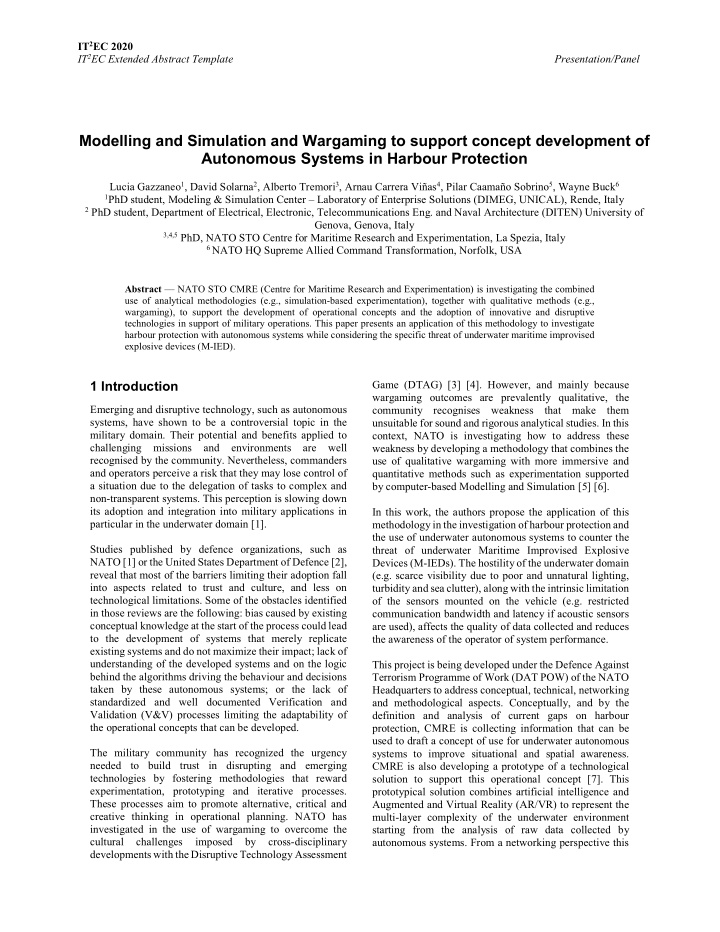



IT 2 EC 2020 IT 2 EC Extended Abstract Template Presentation/Panel Modelling and Simulation and Wargaming to support concept development of Autonomous Systems in Harbour Protection Lucia Gazzaneo 1 , David Solarna 2 , Alberto Tremori 3 , Arnau Carrera Viñas 4 , Pilar Caamaño Sobrino 5 , Wayne Buck 6 1 PhD student, Modeling & Simulation Center – Laboratory of Enterprise Solutions (DIMEG, UNICAL), Rende, Italy 2 PhD student, Department of Electrical, Electronic, Telecommunications Eng. and Naval Architecture (DITEN) University of Genova, Genova, Italy 3,4,5 PhD, NATO STO Centre for Maritime Research and Experimentation, La Spezia, Italy 6 NATO HQ Supreme Allied Command Transformation, Norfolk, USA Abstract — NATO STO CMRE (Centre for Maritime Research and Experimentation) is investigating the combined use of analytical methodologies (e.g., simulation-based experimentation), together with qualitative methods (e.g., wargaming), to support the development of operational concepts and the adoption of innovative and disruptive technologies in support of military operations. This paper presents an application of this methodology to investigate harbour protection with autonomous systems while considering the specific threat of underwater maritime improvised explosive devices (M-IED). 1 Introduction Game (DTAG) [3] [4]. However, and mainly because wargaming outcomes are prevalently qualitative, the Emerging and disruptive technology, such as autonomous community recognises weakness that make them systems, have shown to be a controversial topic in the unsuitable for sound and rigorous analytical studies. In this military domain. Their potential and benefits applied to context, NATO is investigating how to address these challenging missions and environments are well weakness by developing a methodology that combines the recognised by the community. Nevertheless, commanders use of qualitative wargaming with more immersive and and operators perceive a risk that they may lose control of quantitative methods such as experimentation supported a situation due to the delegation of tasks to complex and by computer-based Modelling and Simulation [5] [6]. non-transparent systems. This perception is slowing down its adoption and integration into military applications in In this work, the authors propose the application of this particular in the underwater domain [1]. methodology in the investigation of harbour protection and the use of underwater autonomous systems to counter the Studies published by defence organizations, such as threat of underwater Maritime Improvised Explosive NATO [1] or the United States Department of Defence [2], Devices (M-IEDs). The hostility of the underwater domain reveal that most of the barriers limiting their adoption fall (e.g. scarce visibility due to poor and unnatural lighting, into aspects related to trust and culture, and less on turbidity and sea clutter), along with the intrinsic limitation technological limitations. Some of the obstacles identified of the sensors mounted on the vehicle (e.g. restricted in those reviews are the following: bias caused by existing communication bandwidth and latency if acoustic sensors conceptual knowledge at the start of the process could lead are used), affects the quality of data collected and reduces to the development of systems that merely replicate the awareness of the operator of system performance. existing systems and do not maximize their impact; lack of understanding of the developed systems and on the logic This project is being developed under the Defence Against behind the algorithms driving the behaviour and decisions Terrorism Programme of Work (DAT POW) of the NATO taken by these autonomous systems; or the lack of Headquarters to address conceptual, technical, networking standardized and well documented Verification and and methodological aspects. Conceptually, and by the Validation (V&V) processes limiting the adaptability of definition and analysis of current gaps on harbour the operational concepts that can be developed. protection, CMRE is collecting information that can be used to draft a concept of use for underwater autonomous The military community has recognized the urgency systems to improve situational and spatial awareness. needed to build trust in disrupting and emerging CMRE is also developing a prototype of a technological technologies by fostering methodologies that reward solution to support this operational concept [7]. This experimentation, prototyping and iterative processes. prototypical solution combines artificial intelligence and These processes aim to promote alternative, critical and Augmented and Virtual Reality (AR/VR) to represent the creative thinking in operational planning. NATO has multi-layer complexity of the underwater environment investigated in the use of wargaming to overcome the starting from the analysis of raw data collected by cultural challenges imposed by cross-disciplinary autonomous systems. From a networking perspective this developments with the Disruptive Technology Assessment
Recommend
More recommend